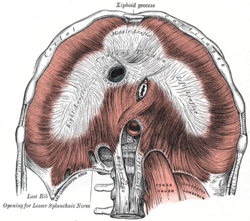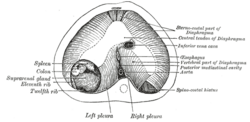Central tendon of diaphragm facts for kids
Quick facts for kids Central tendon of diaphragm |
|
|---|---|
 |
|
| The diaphragm. Under surface. (Central tendon visible as large white central arch.) | |
 |
|
| The thoracic aspect of the diaphragm of a newly born child in which the communication between the peritoneum and pleura has not been closed on the left side; the position of the opening is marked on the right side by the spinocostal hiatus. | |
| Latin | centrum tendineum diaphragmatis |
| Precursor | Septum transversum |
The central tendon is a very important part of your diaphragm. The diaphragm is a large, flat muscle that helps you breathe. The central tendon is like a strong, flat sheet of tissue. It's located a bit towards the front of your body, just above your tummy muscles.
This tendon is connected to your fibrous pericardium, which is a tough sac around your heart. They are joined by a special ligament.
There's also a special opening in the central tendon. It's called the caval opening. Through this opening, a big vein called the inferior vena cava passes. This vein carries blood back to your heart. A nerve called the right phrenic nerve also goes through here.
Contents
What Does the Central Tendon Look Like?
The central tendon has a unique shape. It looks a bit like a trefoil leaf, which is a leaf with three parts. These three parts are sometimes called "leaflets."
- The right leaflet is the biggest.
- The middle leaflet is the next largest. It points towards your xiphoid process, which is the small bone at the bottom of your breastbone.
- The left leaflet is the smallest.
This tendon is made up of many strong fibers. These fibers cross each other in different ways. This special arrangement makes the central tendon extra strong.
How the Central Tendon Helps You Breathe
The central tendon plays a key role when you breathe.
Breathing In (Inspiration)
When you breathe in, your diaphragm muscle contracts. This pulls the central tendon downwards. This action helps to flatten the diaphragm's dome shape.
When the diaphragm moves down, it makes more space inside your chest. This extra space lowers the air pressure in your chest. Because of this lower pressure, air rushes into your lungs. It also helps blood return to your heart.
During this process, the central tendon keeps its shape. This is important because it stops the inferior vena cava (the big vein) from getting squeezed.
Central Tendon and Health Issues
Sometimes, very rarely, a baby might be born with a small hole or weakness in their central tendon. This is called a central congenital diaphragmatic hernia. It means that some organs from the tummy might push up into the chest. Doctors can usually fix this problem with surgery.

